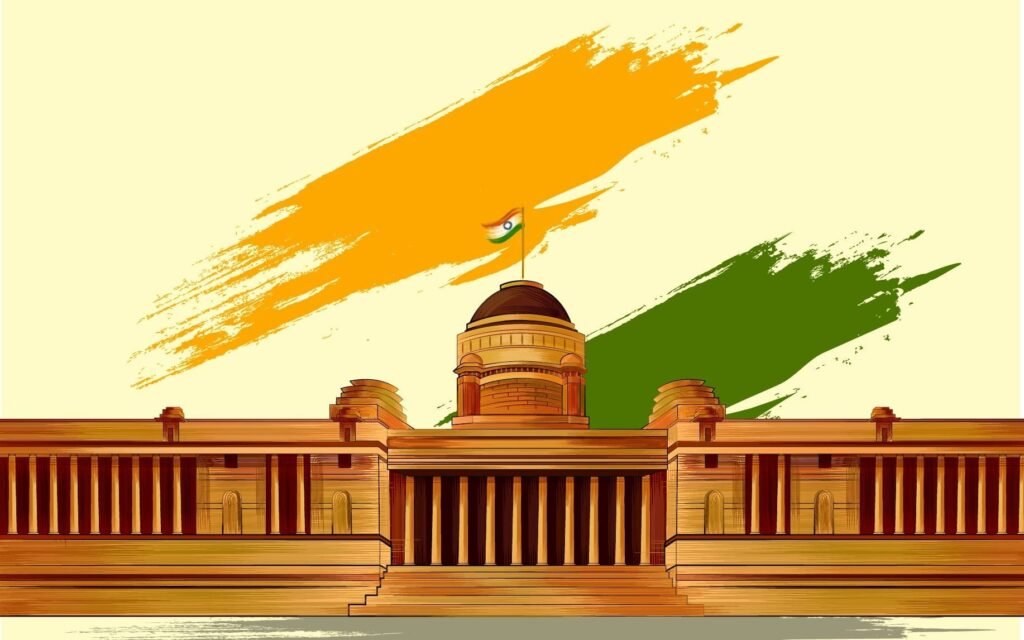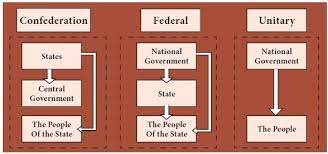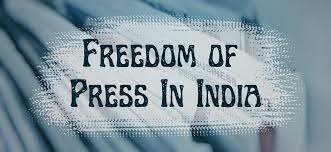
Polity of India
Polity of India which means it has a system of government where the President of India is the head of state, and the Prime Minister is the head of government. Here are some key aspects of Indian polity:
Historical Evolution:

- Ancient and Medieval Polities: Study the political systems of ancient civilizations like the Indus Valley, Vedic period, Maurya, Gupta, and Mughal empires.
- Colonial Era: Understand the impact of British colonial rule, the formation of administrative structures, and the emergence of early political movements.
- Constitution:
The Constitution of India is a remarkable document that reflects the aspirations of a diverse nation. It guarantees fundamental rights to citizens, such as freedom of speech, equality before the law, and protection against discrimination. It also outlines Directive Principles of State Policy, guiding the government in ensuring social, economic, and political justice.
Polity of India : Quick revision - Federal Structure:
- India’s federal structure ensures a balance of power between the central government and states. However, at times, there have been debates about the extent of centralization versus decentralization of power. Issues like state autonomy, fiscal federalism, and inter-state disputes have been prominent discussions.
- Parliamentary System:
India follows a parliamentary system where the executive branch (headed by the Prime Minister) is accountable to the legislative branch (Parliament). This system facilitates cooperation and consensus-building, but it has also seen instances of political instability due to coalition governments. - Separation of Powers:
The Constitution provides for a separation of powers among the executive, legislative, and judicial branches. However, there have been debates about the extent to which these branches remain truly independent, particularly regarding the influence of the executive on the judiciary. - Elections and Political Parties:
India’s electoral process is one of the largest exercises in democratic participation globally. The emergence of regional parties has added complexity to the political landscape, leading to coalition politics and the need for consensus-building. - Reservation Policy:
The reservation policy for Scheduled Castes, Scheduled Tribes, and Other Backward Classes (OBCs) aims to uplift historically marginalized communities. This policy has played a crucial role in promoting social justice, but debates about its effectiveness and potential conflicts persist. - Judiciary and Judicial Activism:
The Indian judiciary has displayed a significant degree of activism, particularly in safeguarding fundamental rights and interpreting the Constitution. This activism has been both lauded for protecting citizens and criticized for judicial overreach. - Secularism and Diversity:
India’s commitment to secularism is enshrined in the Constitution. However, issues related to religious and cultural diversity often result in debates about the proper implementation of secular principles, such as those involving personal laws and religious practices. - Language and Identity:
The linguistic diversity of India has led to discussions about language policies and the preservation of cultural identities. There have been instances of linguistic movements and demands for the recognition of regional languages. - Gender and Representation:
While women have made significant strides in various fields, there remains a considerable gender gap in political representation. Debates continue about the importance of affirmative action, like the Women’s Reservation Bill, to enhance women’s participation in politics. - Human Rights and Governance:
Human rights issues, including freedom of expression, right to privacy, and police reforms, are subjects of intense discussion. Effective governance and administration are crucial to ensure these rights are upheld. - Environmental Concerns:
As India strives for economic growth, environmental challenges like pollution, deforestation, and climate change have come to the forefront. Balancing development with sustainable practices remains a significant concern. - Media and Freedom of Speech:
India has a vibrant media landscape, but concerns about press freedom and challenges related to fake news, censorship, and government control have arisen. - Caste and Identity Politics:
Caste dynamics continue to influence Indian polity. While efforts have been made to eliminate caste-based discrimination, caste-based politics remains a prominent factor in many regions. - Ethnic and Regional Conflicts:
India’s diversity also includes ethnic and regional differences, leading to occasional conflicts. Managing and addressing these conflicts is an ongoing challenge.
also read about
Indian Economics at a glance : Quick revision key factor - Emerging Challenges and Reforms:
- Analyze contemporary challenges such as corruption, judicial backlog, electoral reforms, and administrative efficiency.
Historical background of polity of the India
Historical background of polity of the India
The historical background of the polity of India is a complex and multifaceted story that spans thousands of years. Here is a concise overview of the historical development of India’s polity:
- Ancient India: India has a rich political and cultural history dating back to ancient times. Various dynasties and empires ruled different parts of the Indian subcontinent. Prominent among them were the Maurya and Gupta Empires, which saw the consolidation of large territorial empires and the development of early administrative systems.
- Medieval Period: The medieval period in India witnessed the rise of various dynasties, including the Cholas, Chalukyas, Delhi Sultanate, and the Mughal Empire. Each of these rulers brought their own administrative structures and policies to the region. The Mughals, in particular, played a significant role in shaping the Indian subcontinent’s political landscape.
- Colonial Era: The 17th century saw the beginning of European colonialism in India, with the establishment of the British East India Company’s trading posts. Over time, the British expanded their control, and India became a part of the British Empire. The colonial period profoundly influenced India’s political, economic, and social structures.
- Struggle for Independence: The 19th and 20th centuries witnessed a series of movements and uprisings against British colonial rule, including the Sepoy Mutiny of 1857 and the non-violent civil disobedience campaigns led by Mahatma Gandhi. These movements ultimately led to India gaining independence from British rule on August 15, 1947.
- Constitutional Assembly: Following independence, India adopted its own Constitution, which came into effect on January 26, 1950. Dr. B.R. Ambedkar chaired the Constituent Assembly and played a crucial role in drafting the Constitution. The Constitution of India is one of the longest and most comprehensive in the world, providing the framework for the country’s democratic and federal system.
- Partition: The partition of India in 1947, which led to the creation of Pakistan, was a momentous event in the region’s history. It resulted in mass migrations, communal violence, and significant changes in the political and demographic landscape.
- Republic of India: India adopted a democratic and republican form of government, with a President as the ceremonial head of state and a Prime Minister as the head of government. India chose to be a secular, socialist, and democratic republic, as enshrined in its Constitution.
- Post-Independence Challenges: After independence, India faced several challenges, including the integration of princely states, economic development, social justice, and nation-building. It also embarked on a policy of non-alignment in international affairs.
- Evolving Political Landscape: Since independence, India’s political landscape has been characterized by a multi-party system, periodic elections, and the peaceful transfer of power. Various political parties with diverse ideologies have governed the country at the national and state levels.
- Economic Reforms: In the 1990s, India initiated economic reforms, liberalizing its economy and opening it up to globalization. This shift had a significant impact on India’s economic and political landscape, leading to increased economic growth and global influence.
India’s political journey is marked by its diversity, challenges, and the continuous evolution of its political system. It has grown into the world’s largest democracy with a vibrant political culture and a commitment to upholding democratic values and principles.
What is Indian political system
what is Indian political system
The Indian political system is a federal parliamentary democratic republic. Here are the key elements and features that define the Indian political system:
- Federal System: India is a federal state with a division of powers between the central government (Union) and individual states and union territories. The distribution of powers is outlined in the Constitution, with certain subjects under the exclusive jurisdiction of the central government, others under the exclusive jurisdiction of state governments, and some shared subjects.
- Parliamentary Democracy: India follows the parliamentary system of government. It has a President as the nominal head of state, while the real executive power is vested in the Prime Minister, who is the leader of the majority party or coalition in the Lok Sabha (House of the People).
- Bicameral Legislature: India’s legislature consists of two houses: the Rajya Sabha (Council of States) and the Lok Sabha (House of the People). Members of the Rajya Sabha are not directly elected but are appointed by the state legislatures. Members of the Lok Sabha are directly elected by the people.
- Universal Adult Suffrage: India practices universal adult suffrage, allowing every adult citizen, regardless of caste, creed, religion, gender, or economic status, to vote in elections.
- President as Ceremonial Head: The President of India is the ceremonial head of state. While the President plays a role in the functioning of the government, such as appointing the Prime Minister, the real executive power rests with the Prime Minister and the Council of Ministers.
- Independent Judiciary: India has a strong and independent judiciary, with the Supreme Court at the apex. The judiciary is responsible for interpreting the Constitution and safeguarding the rights of citizens.
- Secular State: India is a secular state, meaning that the government does not favor any particular religion. It ensures freedom of religion and the right to practice and propagate any religion.
- Fundamental Rights and Directive Principles: The Indian Constitution guarantees fundamental rights to its citizens, including the right to equality, freedom of speech and expression, and the right to constitutional remedies. It also includes Directive Principles of State Policy, which provide guidelines for the government to promote social justice, economic welfare, and the overall well-being of the people.
- Elections: India conducts regular elections at various levels of government, including the Lok Sabha, state legislatures, and local bodies. These elections are held through a democratic process.
- Multi-Party System: India has a multi-party political system, with a wide array of political parties representing various ideologies and interests. Coalition governments are common at both the central and state levels due to the diversity of political parties.
- Reservation System: India has a reservation system to ensure social justice and upliftment of historically disadvantaged groups, such as Scheduled Castes (SC), Scheduled Tribes (ST), and Other Backward Classes (OBC), in education and public employment.
- Constitutional Amendments: The Constitution of India can be amended through a well-defined process that involves approval by a special majority in both houses of Parliament or through a national referendum in certain cases.
Overall, India’s political system is characterized by its commitment to democracy, diversity, and the rule of law, as outlined in its Constitution. It is one of the world’s largest and most vibrant democracies
Nature of Indian polity
nature of Indian polity
The nature of the Indian polity can be understood by examining the fundamental principles and characteristics that define its political system. The Indian polity exhibits the following key characteristics:
- Democratic: India is a vibrant and functioning democracy. It adheres to the principles of representative democracy, where citizens have the right to vote in free and fair elections to choose their leaders at various levels of government, including the national, state, and local levels.
- Republic: India is a republic, which means that it does not have a hereditary monarchy. Instead, the country’s head of state, the President, is elected by an electoral college for a fixed term.
- Federal with Unitary Features: India has a federal system of government where powers are divided between the central (Union) government and individual states and union territories. However, in times of emergency, the Constitution grants the central government certain unitary powers, which allows it to temporarily override state authority.
- Parliamentary Democracy: India follows the parliamentary system of government. The executive branch of government is derived from and accountable to the legislature. The Prime Minister, who is the head of government, is usually the leader of the majority party in the Lok Sabha (House of the People).
- Multi-Party System: India has a multi-party political system with numerous political parties representing a wide range of ideologies and interests. Coalition governments are common, especially at the central and state levels, due to the diversity of political parties.
- Rule of Law: The Indian polity is characterized by the rule of law, which means that all individuals and institutions, including the government, are subject to and accountable under the law. An independent judiciary ensures the enforcement of laws and protection of citizens’ rights.
- Secular: India is a secular state, which means that it does not favor any particular religion and guarantees freedom of religion to all citizens. The government is committed to maintaining equal respect for all religions.
- Constitutional: The Indian polity operates under a well-defined and comprehensive Constitution. The Constitution of India, adopted in 1950, serves as the supreme law of the land, providing the framework for the country’s political system, rights of citizens, and governance.
- Socialist and Welfare State: The Indian Constitution includes a commitment to socialism, aiming to ensure social and economic justice. It enshrines Directive Principles of State Policy that guide the government in promoting the welfare of the people, reducing economic inequalities, and improving the standard of living.
- Diversity: India is a diverse country with a wide range of languages, cultures, religions, and traditions. The Indian polity recognizes and respects this diversity and strives to maintain unity in diversity.
- Elections and Universal Adult Suffrage: Regular elections are a hallmark of the Indian political system. Universal adult suffrage allows all adult citizens to participate in the electoral process, irrespective of caste, creed, religion, gender, or economic status.
- Reservations: To promote social justice and upliftment of historically disadvantaged groups, the Indian polity has a reservation system in place, particularly for Scheduled Castes (SC), Scheduled Tribes (ST), and Other Backward Classes (OBC), in education and public employment.
Overall, the nature of the Indian polity reflects its commitment to democracy, social justice, secularism, and diversity, as enshrined in its Constitution. It is a complex and dynamic political system that strives to uphold the principles of justice, equality, and liberty for all its citizens.
Key facts of polity of India
key facts of polity of India
India’s polity, as outlined in its Constitution, is characterized by several key facts and features. Here are some essential aspects of India’s political system:
- Federal System with Unitary Features: India has a federal system of government where power is divided between the central government (Union) and individual states and union territories. However, the Indian Constitution grants the central government certain unitary or overriding powers during emergencies.
- Parliamentary Democracy: India follows the parliamentary system of government. It has a President as the nominal head of state, while the real executive power is vested in the Prime Minister, who is the leader of the majority party in the Lok Sabha (House of the People).
- Bicameral Legislature: India has a bicameral legislature, consisting of the Rajya Sabha (Council of States) and the Lok Sabha. Members of the Rajya Sabha are not directly elected but are appointed by the state legislatures. Members of the Lok Sabha are directly elected by the people.
- Universal Adult Suffrage: One of the key features of India’s polity is universal adult suffrage, which means that every adult citizen has the right to vote regardless of caste, creed, religion, gender, or economic status.
- Fundamental Rights: The Constitution of India guarantees fundamental rights to its citizens, including the right to equality, freedom of speech and expression, and the right to constitutional remedies. These rights are enforceable in a court of law.
- Directive Principles of State Policy: India’s Constitution also includes Directive Principles of State Policy, which are non-justiciable guidelines for the government to promote social justice, economic welfare, and the overall well-being of the people.
- Independent Judiciary: India has a strong and independent judiciary, with the Supreme Court at the apex. The judiciary is responsible for interpreting the Constitution and safeguarding the rights of citizens.
- Secular State: India is a secular state, which means that the government does not favor any particular religion. It ensures freedom of religion and the right to practice and propagate any religion.
- President as Ceremonial Head: The President of India is the ceremonial head of state and plays a role in the functioning of the government, including the appointment of the Prime Minister, but real executive power rests with the Prime Minister and the Council of Ministers.
- Elections: India conducts regular elections at various levels of government, including the Lok Sabha, state legislatures, and local bodies. These elections are held through a democratic process.
- Reservation System: India has a reservation system to ensure social justice and upliftment of historically disadvantaged groups, such as Scheduled Castes (SC), Scheduled Tribes (ST), and Other Backward Classes (OBC), in education and public employment.
- Multi-Party System: India has a multi-party political system, with a wide array of political parties representing various ideologies and interests.
These are some of the key facts that define the polity of India as outlined in its Constitution. India’s political landscape is complex and dynamic, shaped by its rich history, diverse population, and evolving societal needs.
Top 10 political issues in India
top 10 political issues in India
the top political issues in India can change over time due to evolving circumstances and priorities. However, here are ten significant political issues that were relevant
- Economic Growth and Development: India has been striving for sustained economic growth and development, with a focus on job creation, poverty reduction, and infrastructure development.
- COVID-19 Pandemic: Managing the COVID-19 crisis, including vaccination drives, healthcare infrastructure, and economic recovery, was a pressing issue in 2021.
- Agricultural Reforms and Farmer Protests: The government’s efforts to reform agricultural laws led to widespread protests by farmers who were concerned about the impact of these reforms on their livelihoods.
- Unemployment: High levels of unemployment, especially among the youth, were a significant concern. Creating job opportunities and addressing skill gaps were important issues.
- Social and Religious Tensions: India faced challenges related to communalism, religious tensions, and caste-based discrimination, with calls for social harmony and inclusive policies.
- Political Corruption: Corruption remains a concern in Indian politics, with demands for greater transparency and accountability in governance.
- Women’s Rights and Gender Equality: Issues related to women’s safety, gender discrimination, and women’s representation in politics and the workforce were prominent.
- Environmental Sustainability: India grappled with environmental issues such as air pollution, water scarcity, and deforestation. Climate change and sustainable development were central concerns.
- Border Disputes and National Security: Ongoing border disputes with neighboring countries and national security challenges were of paramount importance.
- Education and Healthcare: Improving the quality and accessibility of education and healthcare services remained significant issues for policymakers.
Summary
Here’s a concise summary
The Indian polity is characterized by its democratic, federal, and parliamentary system of government. It is a diverse and dynamic political system that upholds principles of justice, equality, and liberty for all its citizens. Key features include:
- Democratic Republic: India is a functioning democracy where citizens have the right to vote in free and fair elections to choose their leaders.
- Federal System: India has a federal structure, dividing powers between the central government and states/union territories. Unitary features allow central intervention during emergencies.
- Parliamentary Democracy: The Prime Minister, leader of the majority party in the Lok Sabha, is the head of government, and the President is the ceremonial head of state.
- Multi-Party System: India has a diverse multi-party political system, often resulting in coalition governments.
- Rule of Law: The Indian polity operates under the rule of law, with an independent judiciary to enforce laws and protect citizens’ rights.
- Secular State: India is a secular state, guaranteeing freedom of religion and not favoring any particular faith.
- Constitutional Framework: The Indian Constitution, adopted in 1950, serves as the supreme law, outlining the political system, rights of citizens, and governance.
- Socialist and Welfare State: India is committed to socialism and social justice, guided by Directive Principles of State Policy.
- Diversity: India celebrates its unity in diversity, embracing various languages, cultures, religions, and traditions.
- Elections and Universal Adult Suffrage: Regular elections are conducted, allowing all adult citizens to participate in the electoral process.
- Reservations: The reservation system promotes social justice by reserving seats in education and public employment for historically disadvantaged groups.
The Indian polity is marked by its commitment to democracy, social justice, secularism, and diversity, as enshrined in its Constitution. It is a complex and dynamic political system that strives to uphold democratic values and principles.
FAQs
Here are some frequently asked questions (FAQs) related to Indian polity:
- What is the Indian polity?
The Indian polity refers to the political system and governance structure of India, including its democratic principles, government institutions, and constitutional framework. - What type of government does India have?
India has a federal parliamentary democratic republic, characterized by a President as the ceremonial head of state and a Prime Minister as the head of government. - How is the Indian political system structured?
The Indian political system is structured with a division of powers between the central government (Union) and individual states and union territories, following a federal system. - What is the significance of the Indian Constitution?
The Indian Constitution, adopted in 1950, serves as the supreme law of the land, providing the framework for India’s political system, governance, and the rights of its citizens. - Who is the head of state and head of government in India?
The President of India is the ceremonial head of state, while the Prime Minister is the head of government. - What are the key features of India’s political system?
Key features include democracy, secularism, socialism, multi-party politics, rule of law, and universal adult suffrage. - How does India ensure social justice and upliftment of disadvantaged groups?
India has a reservation system that reserves seats in education and public employment for historically disadvantaged groups, such as Scheduled Castes (SC), Scheduled Tribes (ST), and Other Backward Classes (OBC). - What is the role of the Indian judiciary?
The Indian judiciary interprets the Constitution, ensures the rule of law, and safeguards citizens’ rights, with the Supreme Court at the apex. - How often are elections held in India?Regular elections are held at various levels of government in India, including national, state, and local elections, through universal adult suffrage.
- What is the significance of India’s diverse culture and languages in its political system?
India celebrates its unity in diversity, recognizing and respecting various languages, cultures, religions, and traditions. - Is India a secular state?
Yes, India is a secular state, which means that the government does not favor any particular religion and guarantees freedom of religion to all citizens. - How does India address the issue of caste discrimination?
India has constitutional provisions and affirmative action policies to address caste-based discrimination, particularly for Scheduled Castes (SC) and Scheduled Tribes (ST).
These FAQs provide a basic understanding of the Indian polity, its features, and its governance principles. For more in-depth information, further research, or specific questions, it is advisable to consult reputable sources on Indian politics and governance.
read aboutHow to top in Exams Tips | 100% Effective











